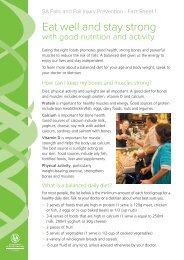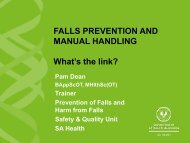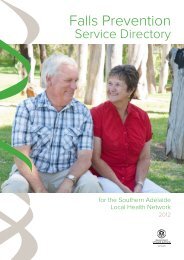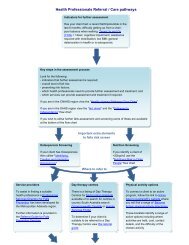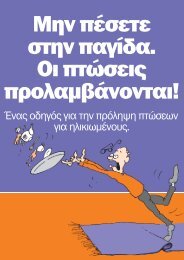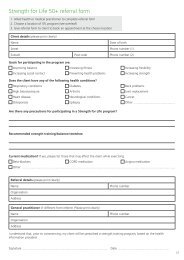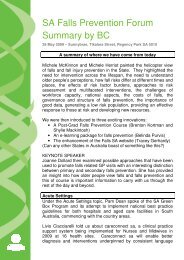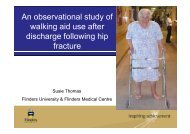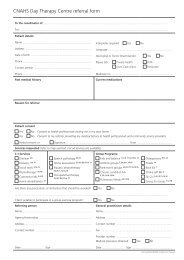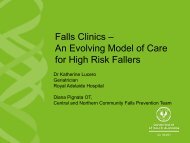Berg Balance Scale - Falls Prevention in SA
Berg Balance Scale - Falls Prevention in SA
Berg Balance Scale - Falls Prevention in SA
Create successful ePaper yourself
Turn your PDF publications into a flip-book with our unique Google optimized e-Paper software.
<strong>Berg</strong> <strong>Balance</strong> <strong>Scale</strong><br />
Description:<br />
14-item scale designed to measure balance of the older adult <strong>in</strong> a cl<strong>in</strong>ical sett<strong>in</strong>g.<br />
Equipment needed: Ruler<br />
2 standard chairs (one with arm rests, one without)<br />
Footstool or step<br />
Stopwatch or wristwatch<br />
15 ft walkway<br />
Completion:<br />
Time: 15-20 m<strong>in</strong>utes<br />
Scor<strong>in</strong>g:<br />
Interpretation:<br />
A five-po<strong>in</strong>t ord<strong>in</strong>al scale, rang<strong>in</strong>g from 0-4. “0” <strong>in</strong>dicates the<br />
lowest level of function and “4” the highest level of function.<br />
Total Score = 56<br />
41-56 = low fall risk<br />
21-40 = medium fall risk<br />
0 –20 = high fall risk<br />
Criterion Validity: “Authors support a cut off score of 45/56 for <strong>in</strong>dependent safe<br />
ambulation”. Riddle and Stratford, 1999, exam<strong>in</strong>ed 45/56 cutoff validity and<br />
concluded:<br />
Sensitivity = 64% (Correctly predicts fallers)<br />
Specificity = 90% (Correctly predicts non-fallers)<br />
Riddle and Stratford encouraged a lower cut off score of 40/56 to assess fall risk<br />
Comments: Potential ceil<strong>in</strong>g effect with higher level patients. <strong>Scale</strong> does not<br />
<strong>in</strong>clude gait items<br />
Page 1 of 4
<strong>Berg</strong> <strong>Balance</strong> <strong>Scale</strong><br />
Name: __________________________________<br />
___________________<br />
Location: ________________________________<br />
___________________<br />
Date:<br />
Rater:<br />
ITEM DESCRIPTION SCORE (0-4)<br />
Sitt<strong>in</strong>g to stand<strong>in</strong>g<br />
Stand<strong>in</strong>g unsupported<br />
Sitt<strong>in</strong>g unsupported<br />
Stand<strong>in</strong>g to sitt<strong>in</strong>g<br />
Transfers<br />
Stand<strong>in</strong>g with eyes closed<br />
Stand<strong>in</strong>g with feet together<br />
Reach<strong>in</strong>g forward with outstretched arm<br />
Retriev<strong>in</strong>g object from floor<br />
Turn<strong>in</strong>g to look beh<strong>in</strong>d<br />
Turn<strong>in</strong>g 360 degrees<br />
Plac<strong>in</strong>g alternate foot on stool<br />
Stand<strong>in</strong>g with one foot <strong>in</strong> front<br />
Stand<strong>in</strong>g on one foot<br />
________<br />
________<br />
________<br />
________<br />
________<br />
________<br />
________<br />
________<br />
________<br />
________<br />
________<br />
________<br />
________<br />
________<br />
Total<br />
________<br />
GENERAL INSTRUCTIONS<br />
Please document each task and/or give <strong>in</strong>structions as written. When scor<strong>in</strong>g,<br />
please record the lowest response category that applies for each item.<br />
In most items, the subject is asked to ma<strong>in</strong>ta<strong>in</strong> a given position for a specific time.<br />
Progressively more po<strong>in</strong>ts are deducted if:<br />
• the time or distance requirements are not met<br />
• the subject’s performance warrants supervision<br />
• the subject touches an external support or receives assistance from the<br />
exam<strong>in</strong>er<br />
Subject should understand that they must ma<strong>in</strong>ta<strong>in</strong> their balance while attempt<strong>in</strong>g<br />
the tasks. The choices of which leg to stand on or how far to reach are left to the<br />
subject. Poor judgment will adversely <strong>in</strong>fluence the performance and the scor<strong>in</strong>g.<br />
Equipment required for test<strong>in</strong>g is a stopwatch or watch with a second hand, and a<br />
ruler or other <strong>in</strong>dicator of 2, 5, and 10 <strong>in</strong>ches. Chairs used dur<strong>in</strong>g test<strong>in</strong>g should be<br />
a reasonable height. Either a step or a stool of average step height may be used<br />
for item # 12.<br />
Page 2 of 4
<strong>Berg</strong> <strong>Balance</strong> <strong>Scale</strong><br />
SITTING TO STANDING<br />
INSTRUCTIONS: Please stand up. Try not to use your hand for support.<br />
( ) 4 able to stand without us<strong>in</strong>g hands and stabilize <strong>in</strong>dependently<br />
( ) 3 able to stand <strong>in</strong>dependently us<strong>in</strong>g hands<br />
( ) 2 able to stand us<strong>in</strong>g hands after several tries<br />
( ) 1 needs m<strong>in</strong>imal aid to stand or stabilize<br />
( ) 0 needs moderate or maximal assist to stand<br />
STANDING UNSUPPORTED<br />
INSTRUCTIONS: Please stand for two m<strong>in</strong>utes without hold<strong>in</strong>g on.<br />
( ) 4 able to stand safely for 2 m<strong>in</strong>utes<br />
( ) 3 able to stand 2 m<strong>in</strong>utes with supervision<br />
( ) 2 able to stand 30 seconds unsupported<br />
( ) 1 needs several tries to stand 30 seconds unsupported<br />
( ) 0 unable to stand 30 seconds unsupported<br />
If a subject is able to stand 2 m<strong>in</strong>utes unsupported, score full po<strong>in</strong>ts for sitt<strong>in</strong>g unsupported. Proceed to item #4.<br />
SITTING WITH BACK UNSUPPORTED BUT FEET SUPPORTED ON FLOOR OR ON A STOOL<br />
INSTRUCTIONS: Please sit with arms folded for 2 m<strong>in</strong>utes.<br />
( ) 4 able to sit safely and securely for 2 m<strong>in</strong>utes<br />
( ) 3 able to sit 2 m<strong>in</strong>utes under supervision<br />
( ) 2 able to able to sit 30 seconds<br />
( ) 1 able to sit 10 seconds<br />
( ) 0 unable to sit without support 10 seconds<br />
STANDING TO SITTING<br />
INSTRUCTIONS: Please sit down.<br />
( ) 4 sits safely with m<strong>in</strong>imal use of hands<br />
( ) 3 controls descent by us<strong>in</strong>g hands<br />
( ) 2 uses back of legs aga<strong>in</strong>st chair to control descent<br />
( ) 1 sits <strong>in</strong>dependently but has uncontrolled descent<br />
( ) 0 needs assist to sit<br />
TRANSFERS<br />
INSTRUCTIONS: Arrange chair(s) for pivot transfer. Ask subject to transfer one way toward a seat with armrests and one<br />
way toward a seat without armrests. You may use two chairs (one with and one without armrests) or a bed and a chair.<br />
( ) 4 able to transfer safely with m<strong>in</strong>or use of hands<br />
( ) 3 able to transfer safely def<strong>in</strong>ite need of hands<br />
( ) 2 able to transfer with verbal cu<strong>in</strong>g and/or supervision<br />
( ) 1 needs one person to assist<br />
( ) 0 needs two people to assist or supervise to be safe<br />
STANDING UNSUPPORTED WITH EYES CLOSED<br />
INSTRUCTIONS: Please close your eyes and stand still for 10 seconds.<br />
( ) 4 able to stand 10 seconds safely<br />
( ) 3 able to stand 10 seconds with supervision<br />
( ) 2 able to stand 3 seconds<br />
( ) 1 unable to keep eyes closed 3 seconds but stays safely<br />
( ) 0 needs help to keep from fall<strong>in</strong>g<br />
STANDING UNSUPPORTED WITH FEET TOGETHER<br />
INSTRUCTIONS: Place your feet together and stand without hold<strong>in</strong>g on.<br />
( ) 4 able to place feet together <strong>in</strong>dependently and stand 1 m<strong>in</strong>ute safely<br />
( ) 3 able to place feet together <strong>in</strong>dependently and stand 1 m<strong>in</strong>ute with supervision<br />
( ) 2 able to place feet together <strong>in</strong>dependently but unable to hold for 30 seconds<br />
( ) 1 needs help to atta<strong>in</strong> position but able to stand 15 seconds feet together<br />
( ) 0 needs help to atta<strong>in</strong> position and unable to hold for 15 seconds<br />
Page 3 of 4
<strong>Berg</strong> <strong>Balance</strong> <strong>Scale</strong> cont<strong>in</strong>ued…..<br />
REACHING FORWARD WITH OUTSTRETCHED ARM WHILE STANDING<br />
INSTRUCTIONS: Lift arm to 90 degrees. Stretch out your f<strong>in</strong>gers and reach forward as far as you can. (Exam<strong>in</strong>er places a<br />
ruler at the end of f<strong>in</strong>gertips when arm is at 90 degrees. F<strong>in</strong>gers should not touch the ruler while reach<strong>in</strong>g forward. The<br />
recorded measure is the distance forward that the f<strong>in</strong>gers reach while the subject is <strong>in</strong> the most forward lean position. When<br />
possible, ask subject to use both arms when reach<strong>in</strong>g to avoid rotation of the trunk.)<br />
( ) 4 can reach forward confidently 25 cm (10 <strong>in</strong>ches)<br />
( ) 3 can reach forward 12 cm (5 <strong>in</strong>ches)<br />
( ) 2 can reach forward 5 cm (2 <strong>in</strong>ches)<br />
( ) 1 reaches forward but needs supervision<br />
( ) 0 loses balance while try<strong>in</strong>g/requires external support<br />
PICK UP OBJECT FROM THE FLOOR FROM A STANDING POSITION<br />
INSTRUCTIONS: Pick up the shoe/slipper, which is place <strong>in</strong> front of your feet.<br />
( ) 4 able to pick up slipper safely and easily<br />
( ) 3 able to pick up slipper but needs supervision<br />
( ) 2 unable to pick up but reaches 2-5 cm(1-2 <strong>in</strong>ches) from slipper and keeps balance<br />
<strong>in</strong>dependently<br />
( ) 1 unable to pick up and needs supervision while try<strong>in</strong>g<br />
( ) 0 unable to try/needs assist to keep from los<strong>in</strong>g balance or fall<strong>in</strong>g<br />
TURNING TO LOOK BEHIND OVER LEFT AND RIGHT SHOULDERS WHILE STANDING<br />
INSTRUCTIONS: Turn to look directly beh<strong>in</strong>d you over toward the left shoulder. Repeat to the right. Exam<strong>in</strong>er may pick an<br />
object to look at directly beh<strong>in</strong>d the subject to encourage a better twist turn.<br />
( ) 4 looks beh<strong>in</strong>d from both sides and weight shifts well<br />
( ) 3 looks beh<strong>in</strong>d one side only other side shows less weight shift<br />
( ) 2 turns sideways only but ma<strong>in</strong>ta<strong>in</strong>s balance<br />
( ) 1 needs supervision when turn<strong>in</strong>g<br />
( ) 0 needs assist to keep from los<strong>in</strong>g balance or fall<strong>in</strong>g<br />
TURN 360 DEGREES<br />
INSTRUCTIONS: Turn completely around <strong>in</strong> a full circle. Pause. Then turn a full circle <strong>in</strong> the other direction.<br />
( ) 4 able to turn 360 degrees safely <strong>in</strong> 4 seconds or less<br />
( ) 3 able to turn 360 degrees safely one side only 4 seconds or less<br />
( ) 2 able to turn 360 degrees safely but slowly<br />
( ) 1 needs close supervision or verbal cu<strong>in</strong>g<br />
( ) 0 needs assistance while turn<strong>in</strong>g<br />
PLACE ALTERNATE FOOT ON STEP OR STOOL WHILE STANDING UNSUPPORTED<br />
INSTRUCTIONS: Place each foot alternately on the step/stool. Cont<strong>in</strong>ue until each foot has touch the step/stool four times.<br />
( ) 4 able to stand <strong>in</strong>dependently and safely and complete 8 steps <strong>in</strong> 20 seconds<br />
( ) 3 able to stand <strong>in</strong>dependently and complete 8 steps <strong>in</strong> > 20 seconds<br />
( ) 2 able to complete 4 steps without aid with supervision<br />
( ) 1 able to complete > 2 steps needs m<strong>in</strong>imal assist<br />
( ) 0 needs assistance to keep from fall<strong>in</strong>g/unable to try<br />
STANDING UNSUPPORTED ONE FOOT IN FRONT<br />
INSTRUCTIONS: (DEMONSTRATE TO SUBJECT) Place one foot directly <strong>in</strong> front of the other. If you feel that you cannot<br />
place your foot directly <strong>in</strong> front, try to step far enough ahead that the heel of your forward foot is ahead of the toes of the<br />
other foot. (To score 3 po<strong>in</strong>ts, the length of the step should exceed the length of the other foot and the width of the stance<br />
should approximate the subject’s normal stride width.)<br />
( ) 4 able to place foot tandem <strong>in</strong>dependently and hold 30 seconds<br />
( ) 3 able to place foot ahead <strong>in</strong>dependently and hold 30 seconds<br />
( ) 2 able to take small step <strong>in</strong>dependently and hold 30 seconds<br />
( ) 1 needs help to step but can hold 15 seconds<br />
( ) 0 loses balance while stepp<strong>in</strong>g or stand<strong>in</strong>g<br />
STANDING ON ONE LEG<br />
INSTRUCTIONS: Stand on one leg as long as you can without hold<strong>in</strong>g on.<br />
( ) 4 able to lift leg <strong>in</strong>dependently and hold > 10 seconds<br />
( ) 3 able to lift leg <strong>in</strong>dependently and hold 5-10 seconds<br />
( ) 2 able to lift leg <strong>in</strong>dependently and hold ≥ 3 seconds<br />
( ) 1 tries to lift leg unable to hold 3 seconds but rema<strong>in</strong>s stand<strong>in</strong>g <strong>in</strong>dependently.<br />
( ) 0 unable to try of needs assist to prevent fall<br />
( ) TOTAL SCORE (Maximum = 56)<br />
Page 4 of 4



